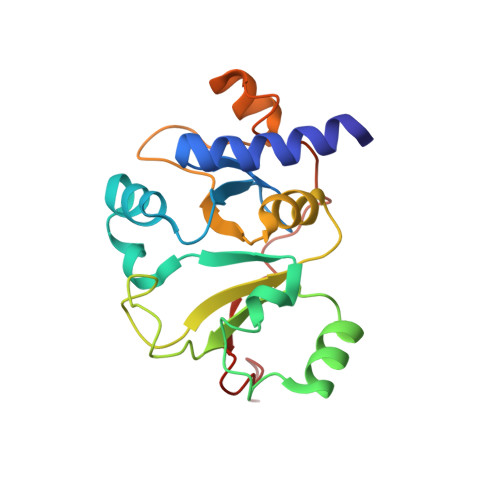NMR-based Structural Analysis of Threonylcarbamoyl-AMP Synthase and Its Substrate Interactions.
Harris, K.A., Bobay, B.G., Sarachan, K.L., Sims, A.F., Bilbille, Y., Deutsch, C., Iwata-Reuyl, D., Agris, P.F.(2015) J Biological Chem 290: 20032-20043
- PubMed: 26060251
- DOI: https://doi.org/10.1074/jbc.M114.631242
- Primary Citation of Related Structures:
2MX1 - PubMed Abstract:
The hypermodified nucleoside N(6)-threonylcarbamoyladenosine (t(6)A37) is present in many distinct tRNA species and has been found in organisms in all domains of life. This post-transcriptional modification enhances translation fidelity by stabilizing the anticodon/codon interaction in the ribosomal decoding site. The biosynthetic pathway of t(6)A37 is complex and not well understood. In bacteria, the following four proteins have been discovered to be both required and sufficient for t(6)A37 modification: TsaC, TsaD, TsaB, and TsaE. Of these, TsaC and TsaD are members of universally conserved protein families. Although TsaC has been shown to catalyze the formation of L-threonylcarbamoyl-AMP, a key intermediate in the biosynthesis of t(6)A37, the details of the enzymatic mechanism remain unsolved. Therefore, the solution structure of Escherichia coli TsaC was characterized by NMR to further study the interactions with ATP and L-threonine, both substrates of TsaC in the biosynthesis of L-threonylcarbamoyl-AMP. Several conserved amino acids were identified that create a hydrophobic binding pocket for the adenine of ATP. Additionally, two residues were found to interact with L-threonine. Both binding sites are located in a deep cavity at the center of the protein. Models derived from the NMR data and molecular modeling reveal several sites with considerable conformational flexibility in TsaC that may be important for L-threonine recognition, ATP activation, and/or protein/protein interactions. These observations further the understanding of the enzymatic reaction catalyzed by TsaC, a threonylcarbamoyl-AMP synthase, and provide structure-based insight into the mechanism of t(6)A37 biosynthesis.
- From the Department of Molecular and Structural Biochemistry, North Carolina State University, Raleigh, North Carolina 27695, The RNA Institute, Departments of Biological Sciences and Chemistry, University at Albany, Albany, New York 12222, and.
Organizational Affiliation:
















